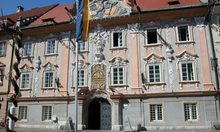Worth knowing
The history of the origins of St. Veit stems from a legend about the Carantanian Duke Ratold and the Hungarian invasion in 901. Saint Veit, patron saint of the Slavic people, appeared to Duke Ratold the night before the decisive battle. He encouraged Ratold to go into battle. After he emerged victorious, he built St. Vitus Church on the battle field in gratitude to the Saint. Settlers came and made their homes around the church, and gradually, the ducal town of St. Veit emerged. The outer wall of today’s city church contains fragments dating back to these origins.
Since the mid-1990's, St. Veit has been committed to renewable energy through solar power. The project "Sonnenstadt St. Veit" was initiated in 2010. The city’s policy makers have a vision of making the city completely self-sufficient by means of renewable energy sources. To that end, the city began building Austria’s largest photovoltaic power plant in 2010. The plant delivers 1,500 kilowatts peak and has an annual output of about 1.5 million kilowatt hours. By 2013, the total photovoltaic surface installed within the city delivered more than three megawatts peak.



